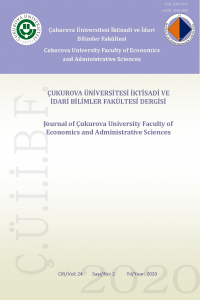Rotterdam Modeline Göre Talep Analizi: Kentsel Çin’in Değerlendirilmesi
Talep Analizi, Esneklik, Rotterdam Modeli
Demand Analysis by Rotterdam Model: An Assessment of Urban China
Demand Analysis, Elasticity, Rotterdam Model,
___
- Andreyeva, T., M.W. Long, and K.D. Brownell. 2010. The Impact of Food Prices on Consumption: A Systematic Review of Research on the Price Elasticity of Demand for Food. American Journal of Public Health 100 (2): 216–22.
- Chen, D., Abler, D., Zhou, D., Yu, X., & Thompson, W. (2015). A meta-analysis of food demand elasticities for China. Applied Economic Perspectives and Policy, 38(1), 50-72.
- Clements, K. W., & Gao, G. (2015). The Rotterdam demand model half a century on. Economic Modelling, 49, 91-103.
- Green, R., Cornelsen, L., Dangour, A. D., Turner, R., Shankar, B., Mazzocchi, M., & Smith, R. D. (2013). The effect of rising food prices on food consumption: systematic review with meta-regression. Bmj, 346, f3703.
- Guneysu Atasoy, F (2019) Demand Analysis Of The Usa’s Meat Products: An Application Of Linear Approximate-Almost Ideal Demand System, In Atik, Atilla (editor), Research & Reviews in Social, Human and Administrative Sciences, (pp 171-180), Gece Publishing, New York, NY, USA. Available at: https://www.gecekitapligi.com/Webkontrol/uploads/Fck/SOCIAL_6.pdf
- Liu, H, and F Zhong. 2009. Food Consumption and Demand Elasticity: Evidence from Household Survey Data. Journal of Nanjing Agricultural University (Social Sciences Edition) 9 (3): 36–43.
- National Bureau of Statistics of China, (2018) http://www.stats.gov.cn/english/, access at: 17/10/2018.
- Washington, A. A., & Kilmer, R. L. (2002). The production theory approach to import demand analysis: A comparison of the Rotterdam model and the differential production approach. Journal of Agricultural and Applied Economics, 34(3), 431-443.
- Zheng, Z.,and Henneberry, S. R. (2009). “An analysis of food demand in China: a case study of urban households in Jiangsu province.” Review of Agricultural Economics, 31(4), 873-893.
- Zhou, D., Yu, X., & Herzfeld, T. (2015). Dynamic food demand in urban China. China Agricultural Economic Review, 7(1), 27-44.
- ISSN: 1300-3747
- Başlangıç: 1987
- Yayıncı: Çukurova Üniversitesi
Menderes Dönemi İktisat Politikaları
Döviz Kuru Oynaklığının Türkiye’deki Ticari Bankaların Performansı Üzerine Etkisi
Konut Fiyatları Üzerine Ampirik Bir Çalışma: Alanya Örneği
Türk-Yunan Nüfus Mübadelesi ve Ekonomiye Olan Etkileri
İhsan Erdem SOFRACI, Melike KAYAM
İktisadi ve İdari Bilimler Öğrencilerinin Ekonomi Okuryazarlık Düzeylerine Yönelik Bir Araştırma
Ebru ÖZGÜR GÜLER, Dilek VEYSİKARANİ
Osmanlı Döneminde Para Vakıfları ve Günümüz Finansal Piyasalarında Para Vakıflarının Yeri
Bağımsız Denetimde Kalite Göstergeleri: Literatür İncelemesi
Koray TUAN, Ramazan BESEN, Ayhan SAYGI
Rotterdam Modeline Göre Talep Analizi: Kentsel Çin’in Değerlendirilmesi
